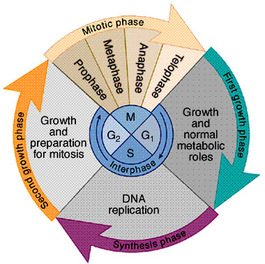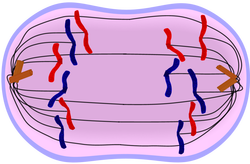The Cell Cycle

The cell cycle refers to the "life" of a cell. Most of a normal cell's life is spent in Interphase. Interphase consists of three periods: Gap 1, Synthesis, and Gap 2. During Gap 1, a cell grows and goes about its normal metabolic processes. Some cells exit the cell cycle at this point, meaning they will not divide. Nerve cells are an example of cells that do not progress beyond Gap 1 in the cell cycle. During Synthesis, the cell replicates its DNA in preparation for division. During Gap 2, the cell grows more and further prepares for Mitosis.
Mitosis is a relatively short, but extremely important period in the cell cycle. The purpose of Mitosis is to make two new cells from one cell. Mitosis is divided into four phases: Prohase, Metaphase, Anaphase, and Telophase.
Mitosis is a relatively short, but extremely important period in the cell cycle. The purpose of Mitosis is to make two new cells from one cell. Mitosis is divided into four phases: Prohase, Metaphase, Anaphase, and Telophase.
The Four Phases of Mitosis and Cytokinesis
ProphaseChromatin condenses to form chromosomes. The nuclear membrane and nuleolus dissolve. Spindle fibers begin to form at the centrioles.
|
MetaphaseSpindle fibers attach to the chromosomes at the centromere. Chromosomes line up along the metaphase plate at the cell's equator.
|
AnaphaseSpindle fibers pull apart the chromosomes, causing sister chromatids to migrate to opposite ends of the cell.
|
TelophaseTwo nuclei begin to form within one cell, divided by a cleavage furrow. The nuclear membrane and nucleolus reform, and chromatids begin to uncondense into chromatin.
|
CytokinesisThe cell membrane pinches off the cell into two new cells. The nulei are completely reformed and the DNA is uncondensed as chromatin.
|
|
Watch the Power Point presentation to learn more about mitosis.
|
| ||||||
|
|
|
Meiosis
Meiosis is a special form of cell division that produces gametes, or sex cells. These cells differ from other cells because they have half the number of chromosomes. Because they have half the number of chromosomes, these are called haploid cells, which are different from somatic, or body cells, which have the full number of chromosomes and are called diploid.
The Phases of Meiosis: During Prohase I the DNA condenses into chromosomes, the nuclear membrane breaks down, and spindle fibers form. This is the same as Mitosis, but there is an additional step called crossing over. Crossing over is when homologous chromosomes line up next to each other and exchange DNA. Homologous chromosomes are a pair of chromosomes (one from Mom and one from Dad) containing the same types of genes. Crossing over occurs during Synapsis, which is when homologous chromosomes pair up during Prophase I. During Metaphase I, homologous pairs of chromosomes line up along the equator of the cell. Spindle fibers attach to each of the chromosomes. During Anaphase I, one chromosome from each homologous pair moves to each side of the cell. It is important to make the distinction here between the migration of a chromosome as seen here, and the migration of a sister chromatid, as seen in Mitosis and Anaphase II. Telophase I only occurs in cells that are going to become eggs. In females, Meiosis I takes place before birth, then the process halts until ovulation begins. Telophase I involves the reformation of the nuclear membrane and the uncondensation of the DNA. Since males make sperm cells immediately, there is no need to return to that state. In both cases, cytokinesis takes place, resulting in two cells. |
Watch the Power Point to learn more about meiosis.
| ||||||






